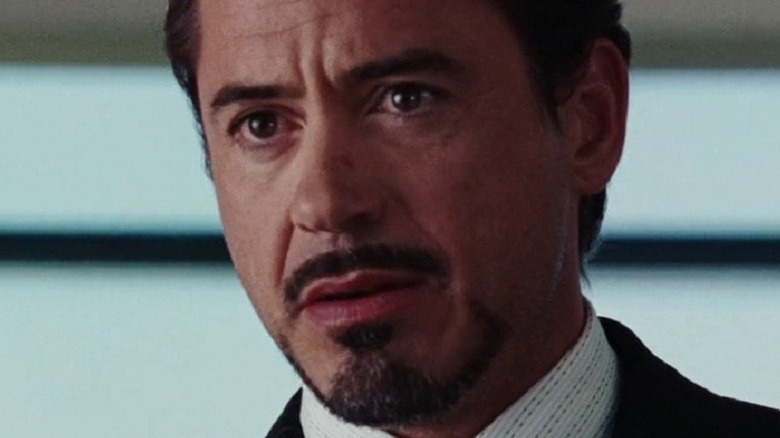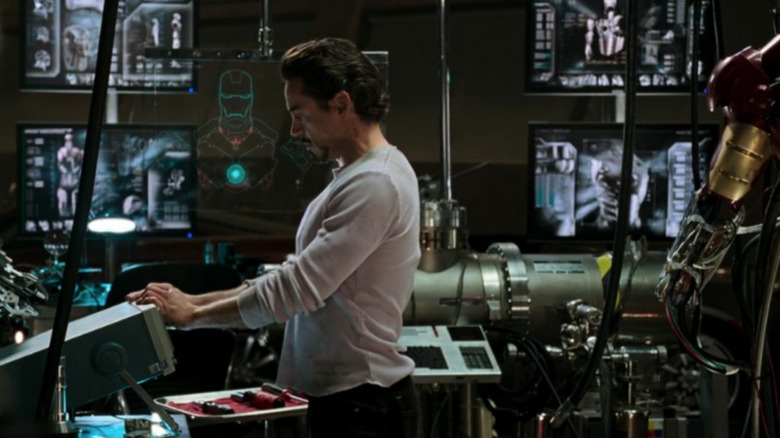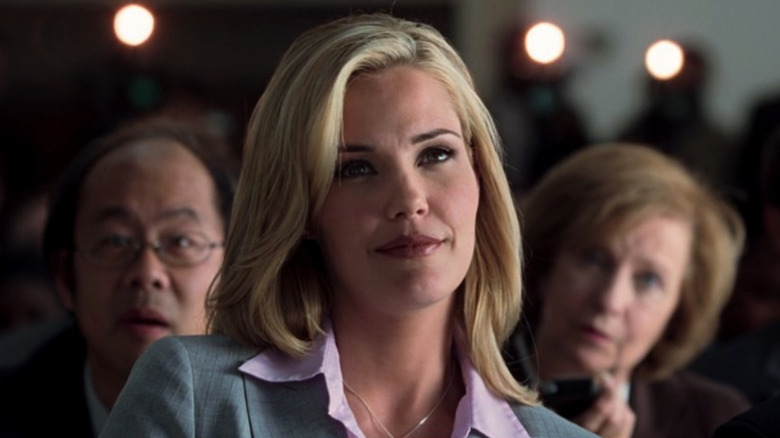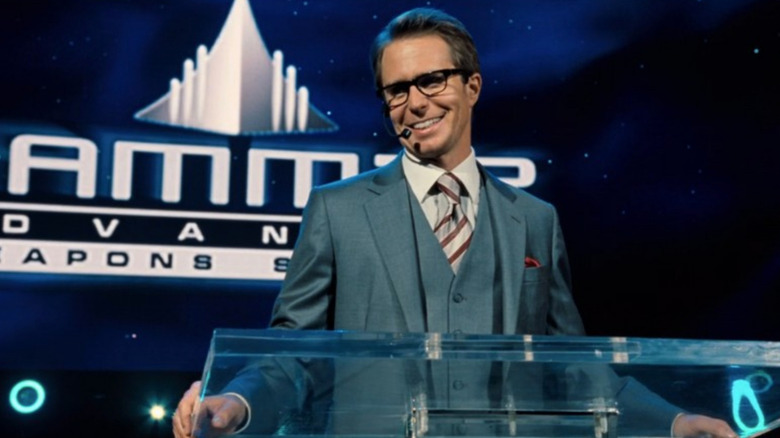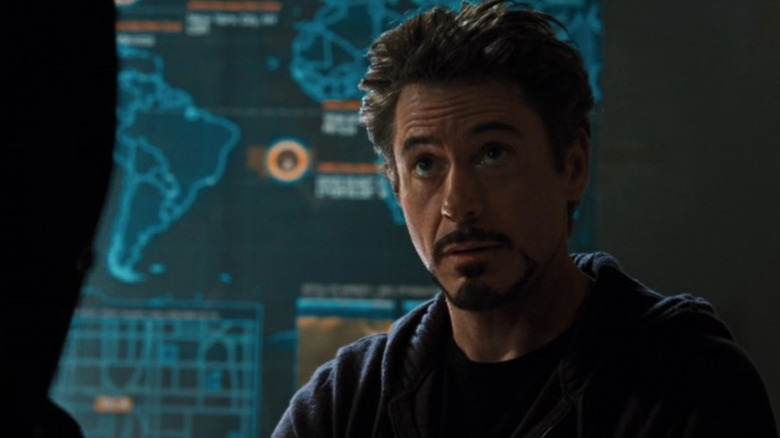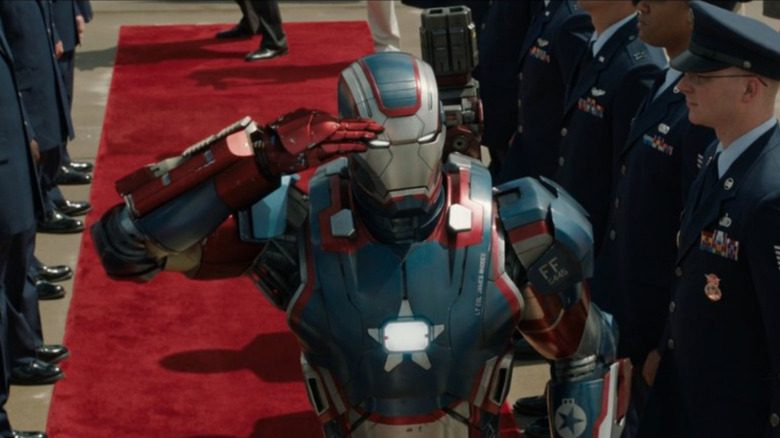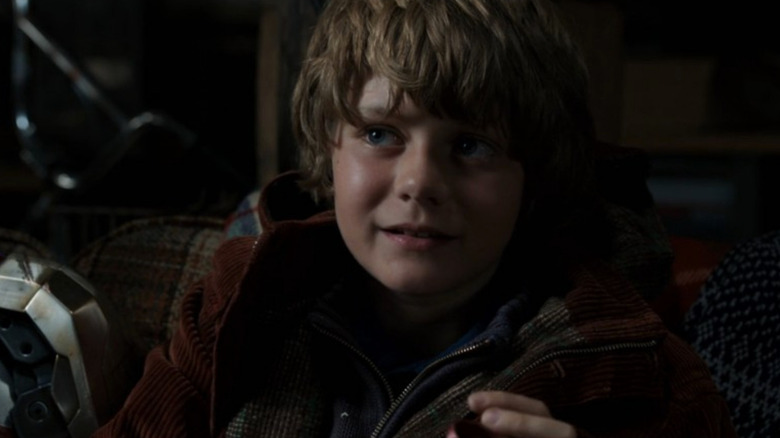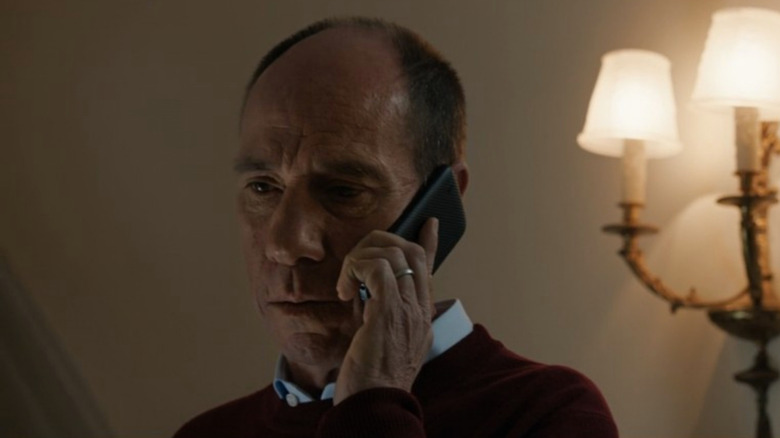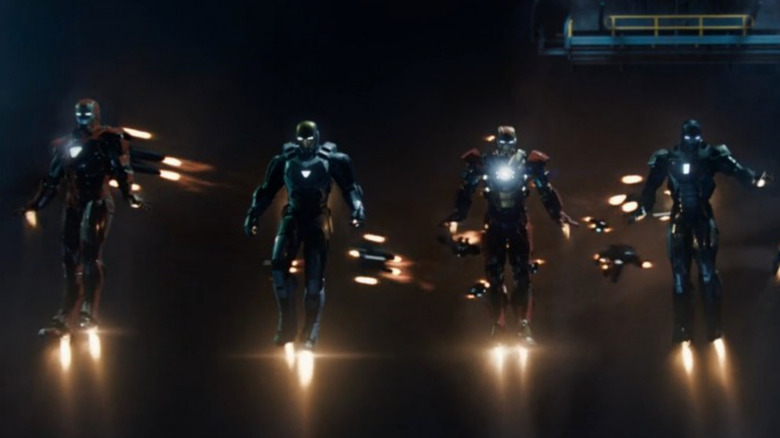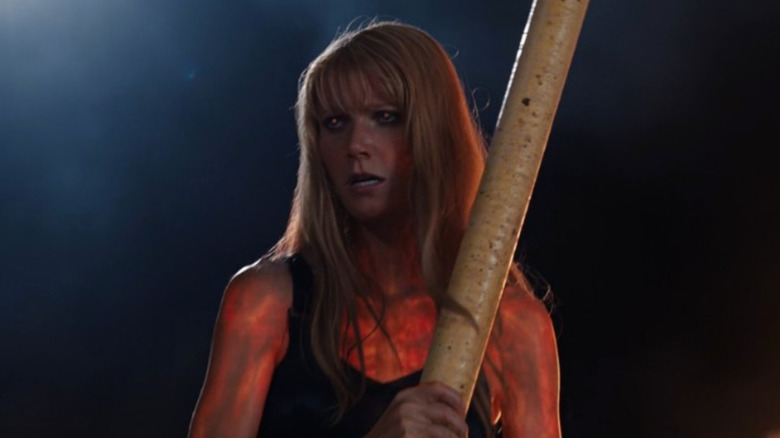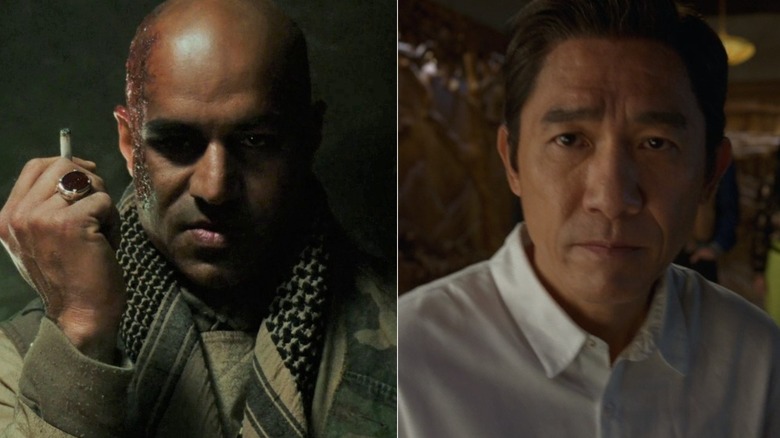Storylines In The Iron Man Trilogy That Disappeared Without Explanation
Compared to the modern state of the Marvel Cinematic Universe, it's easy the look back at the original "Iron Man" trilogy and consider it rather quaint. By today's standards, where dozens of different superheroes will appear in the latest "Avengers" movie and viewers can enjoy at least 3-4 Disney+ shows per year, the relatively grounded story of weapons manufacturer Tony Stark (immortalized by the great Robert Downey Jr.) learning to rise above his dark past and use his tech genius to save lives rather than destroy them seems remarkably straightforward. No alien conquerors or time-traveling wizards to be found in these films, just a character study about a man who builds increasingly elaborate mechanical suits.
Yet despite their simplicity next to the more universe-threatening stakes found in other MCU entries, the "Iron Man" trilogy manages to include a wide variety of plot threads, Easter eggs, and other references to the greater comic book world that these stories originated from. But while many of these storylines were carried through into Tony's other appearances (including "Captain America: Civil War," "Spider-Man: Homecoming," and all four "Avengers" movies), there are quite a few that were introduced and then abandoned in future installments, despite their potential ramifications. Here are the plot points from the "Iron Man" films that have seemingly disappeared without explanation.
Tony's mission to destroy his weapons
In Jon Favreau's 2008 film that paved the way for everything Marvel Studios would go on to produce, the main thrust of the plot involves Tony Stark coming to the realization that the weapons his company creates have been falling into terrorist hands. This is something he discovers firsthand when they're used to attack him and the convoy of American soldiers protecting him. Wracked with guilt and resolving to right these wrongs, he develops his Iron Man persona, which he uses to defend the town of Gulmira and destroy the Stark Industries arsenal being used against the people there.
Upon his return to Malibu, he proclaims to his long-suffering assistant, Pepper Potts (Gwyneth Paltrow), that his only focus going forward is the destruction of these weapons. In his own words, "There is nothing except this. ... There is the next mission, and nothing else." One might naturally assume that these missions would be a major part of the character's trajectory going forward, but after this scene, his conflicts seems to exclusively revolve around supervillains. There is some throwaway dialogue at the beginning of "Iron Man 2" about how he liberated the Middle East between films, but we never see this, and clearly it wasn't so taxing as to prevent him from initiating the year-long Stark Expo just a few months later.
Christine Everhart
Before his transformation into a hero, Tony Stark is characterized as a billionaire playboy with a love for gambling, drinking, and womanizing. To that latter point, one of his earliest interactions in the first "Iron Man" is with journalist Christine Everhart (Leslie Bibb), who initially confronts him on the deadly consequences of his arms dealing before being seduced and going to bed with him that same night. Though she's later shown the door by Pepper, Christine pops up again later in the film to challenge Tony on his company's accountability and again to cast doubt on the official story surrounding his fight with Iron Monger (Jeff Bridges), which directly leads to his famous reveal — "I am Iron Man."
Based on these interactions, it's clear that Christine had potential as a figure who could call Tony out on his mistakes while also serving as a constant reminder of his cavalier past as he attempts to form a more stable relationship with Pepper. Yet this potential was never fully capitalized on. She makes a brief appearance in "Iron Man 2," where she abandons an interview with Justin Hammer (Sam Rockwell) to cover Tony's antics at Monaco, and she shows up in a few marketing videos in her capacity as a reporter, as well as making a blink-and-miss-it cameo in an episode of Marvel's animated "What If...?" series. But beyond that, she's yet to return in any of the films. Now that Tony has passed away in the main narrative, her reappearance seems even less likely.
Justin Hammer
Justin Hammer, the rival arms dealer introduced in "Iron Man 2," initially seemed like the perfect foil to Tony Stark. When Tony cancels his weapon contracts after his experiences in Afghanistan, Hammer's company scoops them up. Though he presents a friendly face to the press, Hammer is clearly resentful of working in Tony's shadow, which spurs him to rescue Ivan Vanko (Mickey Rourke) from prison after the latter demonstrates his ability to recreate the arc reactor technology. This backfires horribly, as Vanko's drones wreak havoc on the Stark Expo, leading to Hammer's arrest.
Despite only being the film's secondary villain, Rockwell made the most of his role with a charismatic performance, and considering that he outright promises Pepper that she'll see him again as the cops take him away, it's clear that there were plans at one point for him to return. However, outside of a brief cameo in the One-Shot "All Hail the King," Hammer has yet to make good on that promise. There are rumors that he might be poised to finally make his comeback in the Disney+ series "Armor Wars," which would reunite him with Don Cheadle's Rhodey, but nothing has been confirmed at this stage.
The existence of Atlantis
Near the end of "Iron Man 2," Tony has a meeting with SHIELD director Nick Fury (Samuel L. Jackson) to discuss his potential candidacy for the Avengers Initiative. Though an assessment by undercover agent Natasha Romanoff (Scarlett Johansson) ultimately determines that while Iron Man would make for an excellent inclusion, Tony Stark would be more problematic, it's implied that this is only a temporary speed bump on the way to him fully joining the team in 2012's "The Avengers." However, Tony's status in the group isn't the only thing being set up by this scene.
Behind Tony is a map showing various points of interest across the globe, and many fans theorized that these would ultimately prove to be important locations later in the series. For example, a point located in Africa foreshadows the appearance of Wakanda, which was eventually showcased in 2018's "Black Panther." Nearby is a point in the middle of the ocean. It has long been thought that this is a reference to the lost city of Atlantis, home to popular Marvel character Namor the Sub-Mariner. (Or at the very least, it's been theorized to be Namor's private hangout.) So far, at least, this has yet to come into play within the greater MCU.
Iron Patriot
In response to the growing terrorist presence of the Mandarin (Ben Kingsley), the U.S. military takes their loyal Col. James "Rhodey" Rhodes, who'd previously appeared as the heroic War Machine, and rebrands him as the more jingoistic Iron Patriot, complete with a new coat of paint intended to play up his status as an all-American protector. There is a running joke throughout "Iron Man 3" about how, despite going along with this change, Rhodey isn't thrilled with the new name and secretly prefers being called War Machine.
Though the terrorist group (revealed to be a front orchestrated by the villainous organization AIM) is ultimately disbanded by the end of the film, it's curious that we never see the Iron Patriot persona return in any of the movies. In all future appearances, Rhodey's armor is back to the classic gunmetal-gray color scheme of War Machine, and he appears to work in conjunction with both the military and the Avengers, though his official capacity in either organization is left vague. One imagines that the government would want to hold on to the Iron Patriot design to bolster their presence on the world stage (especially after Captain America goes rogue in "Civil War"), but apparently, that's not the case.
Harley Keener
Following the attack on his beach house early in "Iron Man 3," Tony finds himself in the middle of Tennessee thanks to a previous flight path set up by JARVIS. Forced to hunt down leads on the Mandarin's bombings without any of his usual resources to rely on, he finds himself joining forces with Harley Keener (Ty Simpkins), a tech-savvy young boy who helps to house the damaged Iron Man armor and even saves Tony's life at one point. At the end of the film, Harley returns home to find that Tony has gifted him with a state-of-the-art workplace as thanks for his assistance.
This combined with their brief but memorable camaraderie throughout the film would suggest that there were big plans to have Harley continue on as a sort of apprentice/sidekick to Tony in future adventures. This never materialized, though, and there's a pretty obvious reason why. Shortly after this film released, Marvel worked out a deal with Sony to use the character of Spider-Man in the MCU, the result of which being that Peter Parker (Tom Holland) quickly ended up filling the Iron Man protégé role that Harley might have held. His presence now redundant, Harley only made one further appearance: He can be seen at Tony's funeral in "Avengers: Endgame," though he looks so much older that many audience members may not have even recognized him.
The vice president's betrayal
There are many plot twists sprinkled throughout "Iron Man 3," the most attention-grabbing being the reveal that Ben Kingsley's version of the Mandarin is little more than a puppet, an actor used to obscure the machinations of the film's real villain (Guy Pearce's Aldrich Killian). However, when Tony and Rhodey reach out to Vice President Rodriguez (Miguel Ferrer) to warn him about an impending attack on President Ellis (William Sadler), we also learn that the VP is in cahoots with Killian, and he's willing to turn a blind eye to Ellis' potential assassination.
Naturally, our heroes end up saving the commander-in-chief, and the treacherous VP gets arrested at the end. Though we learn he was motivated by the possibility of using Extremis to heal his amputee daughter, this whole storyline is largely skimmed over in the face of the larger narrative, and despite getting a legendary character actor like Miguel Ferrer to play the role, he only gets a few minutes of screentime. The ramifications and long-running consequences of a vice president collaborating with a terrorist organization in a plot to have his running mate killed should be catastrophic, yet it's never even addressed in later films, much less dealt with in any meaningful way. In the wake of Ferrer's passing in 2017, it's unlikely that it ever will be.
Tony destroying his suits
A running theme in "Iron Man 3" is the notion that Tony's drive to keep inventing new suits and safeguard the people he cares about is ultimately alienating himself from his loved ones and damaging his mental health. Though he's able to call on a vast number of unique designs to help combat Killian's soldiers in the finale, he comes to the realization that he can't hold onto his relationship with Pepper and his addiction to building at the same time. In a character-defining moment of sacrifice, he activates the "Clean Slate" protocol and destroys all of his remaining suits following the battle's culmination.
This should mark a massive shift in Tony's growth over the course of the overall franchise. As a man who has defined himself by his ability to create and by a near-symbiotic relationship to the Iron Man persona, his choice to leave all of that behind in favor of his love for Pepper and his personal evolution is incredibly significant.
Except that it doesn't stick. The next time we see Tony, in "Avengers: Age of Ultron," he has a new Iron Man suit, a swarm of drones known as the Iron Legion, and a massive Hulkbuster suit co-developed with Bruce Banner (Mark Ruffalo). Plus, his commitment to tinkering inadvertently leads to the creation of Ultron (James Spader), the film's genocidal AI supervillain. Though it's eventually revealed in "Captain America: Civil War" that his return to a state of constant invention caused a rift in his relationship with Pepper, it's still jarring to see such a monumental shift in Tony's personality be all but ignored by the time the next film rolls around.
Residual effects of Extremis
Central to the major conflict of "Iron Man 3" is an experimental drug known as Extremis, which gifts its users incredible regenerative abilities (limbs can grow back and wounds can be healed in a matter of moments), but it also proves extremely unstable and leads to a few of them violently exploding. The Mandarin and the Ten Rings organization are co-opted in an attempt to cover up these failed experiments, but Iron Man ultimately uncovers the truth and is able to shut them down and take out their leader, with the help of Pepper, who'd been kidnapped and injected with Extremis. This backfires, as the drug ends up giving her incredible strength and reflexes, enabling her to land the final blow on Killian.
However, her now having the drug in her system should be a massive issue, considering she can burn through most surfaces by touching them and might potentially blow up if she gets too hot. Fortunately for her, this all comes up just a few minutes before the end of the movie, so rather than deal with the long-term effects of such a traumatic experience, the problem is hand-waved away by having Tony say that he was able to cure her at some indeterminate point off-screen. If there is any lasting impact from Pepper's volatile condition, we never learn about it in the movies. After this installment, she only ever appears in quick cameos, none of which suggest that she feels anything other than normal.
Iron Man's Ten Rings vs. Shang-Chi's Ten Rings
The Mandarin as a character has always presented a problem for the MCU. In the comics, he is Iron Man's greatest archenemy, the Joker to his Batman. It was inevitable that he'd have to appear on film at some point following the first movie's success. The issue is that, as presented on the page, he tends to trade in a lot of Asian stereotypes, which makes him incredibly difficult to adapt. Plus, the Mandarin comes with plenty of mystical elements, and the original "Iron Man" films were a lot more grounded in the realistic world than later films in the franchise.
So how did the MCU get around this? In the first film, the terrorist group that kidnaps Tony calls themselves the Ten Rings, a reference to the Mandarin's signature weapons, although the similarities largely end there. "Iron Man 3" made the controversial choice of introducing Ben Kingsley as a more real-world incarnation of the character, only to reveal him as an actor playing a character. Guy Pearce's Killian claims to be the real Mandarin, but neither version really track with the original character.
In 2021, not long after Tony Stark's movie death, a newly definitive iteration was introduced via Tony Leung's Wenwu in "Shang-Chi and the Legend of the Ten Rings," who's depicted as a warlord who's been around for centuries and utilizes magical bracelets that give him both incredible power and long-lasting life. (We also learn he's well-aware of the fake Mandarin from "Iron Man 3" and not a big fan.) This is closer to the comic character — and significantly less problematic — but it also doesn't fully square up with what we see of the Ten Rings in the "Iron Man" trilogy. Was the group in the first film part of Wenwu's organization or another group that stole the name (a la Killian)? Their leader Raza (Faran Tahir) seemed to have his own world-conquering designs prior to his death, so it's hard to say how much they're connected, if at all. You can make it work if you really try, but it doesn't come easily.
